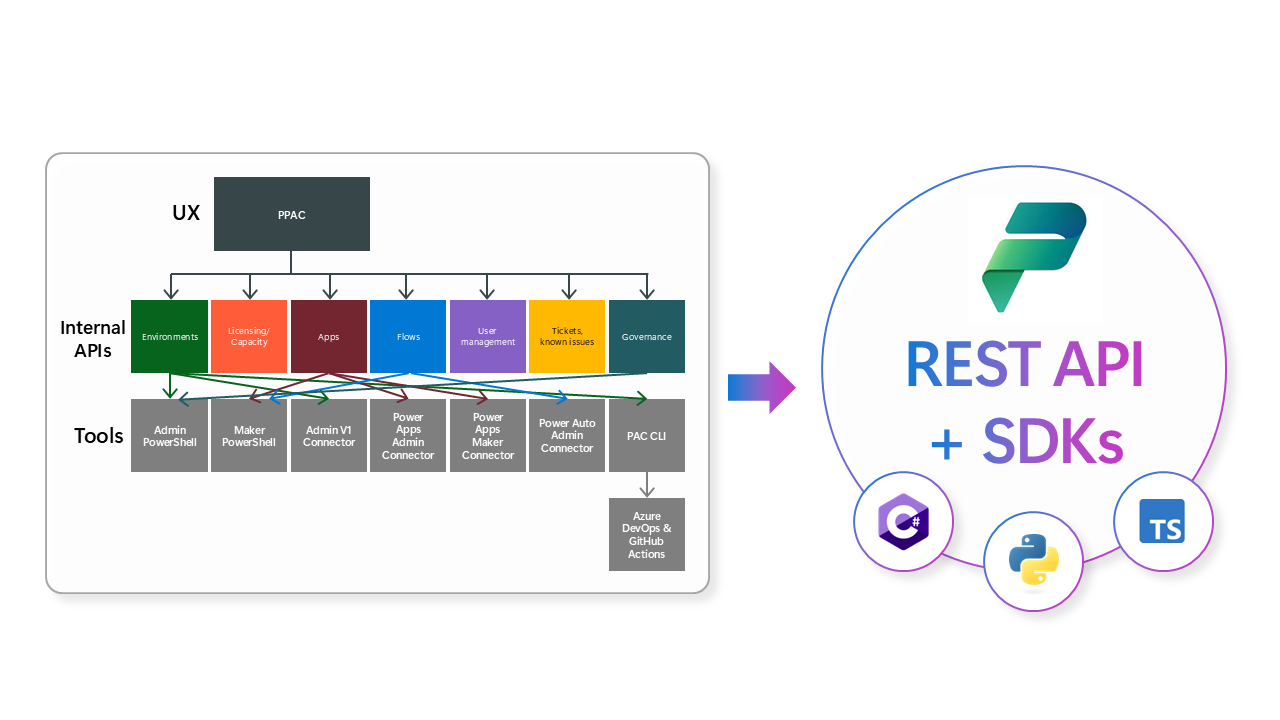Historically, Power Platform has empowered administrators through the Power Platform Admin Center (PPAC). This UX-first experience offered a seamless, intuitive interface for managing environments, automating everyday tasks, and discovering new capabilities within the platform.
Today, we’re taking a bold step forward. We’re transforming Power Platform into an API-first ecosystem—where every feature in PPAC is backed by a well-documented, publicly accessible API. This evolution unlocks intelligent copilots, scalable automation, and enterprise-grade management experiences that are more accessible than ever before. The future of Power Platform is about flexibility, extensibility, and empowering every developer and admin with the tools to innovate at scale.
A unified, intelligent control plane
Our vision is to consolidate all internal APIs behind a single Power Platform API gateway. This enables:
- Centralized audit logging: Uniform logging across all management experiences, integrated with Microsoft Purview.
- Granular role-based access control (RBAC): Fine-grained permissions like Environments, bundled into reusable roles.
- Consistent developer experience: Every feature in PPAC will have a corresponding API, ensuring parity and discoverability.
SDKs for every developer
We’re investing in SDKs across multiple languages to meet developers where they are. At Microsoft Build 2025, we launched our first official C# SDK.
This SDK is just the beginning. We’re using Microsoft Graph’s Kiota tool to generate SDKs in C#, TypeScript, Python, our Power Platform for Admins V2 connector available in both Logic Apps and Power Automate, and more to come. Kiota allows us to generate strongly typed SDKs from OpenAPI descriptions, ensuring consistency and reducing manual engineering effort.
CLI and PowerShell support
We’re also working closely with the Azure Resource Management (ARM) team to align our CLI and PowerShell tooling with Azure standards. This includes:
- Unified command structures
- Support for service principals and managed identities
- Eventually supporting a cloud-shell experience in PPAC
By embracing industry-standard command structures and integrating robust identity solutions like service principals and managed identities, we’re making Power Platform administration more secure, and more consistent with the broader Microsoft ecosystem.
Model Context Protocol (MCP) server support
MCP (Model Context Protocol) is emerging as a foundational element in the integration of generative AI within Power Platform management. By adopting MCP, we’re enabling simplified interoperability between management tools and generative AI models, allowing both IT professionals and makers to interact with their environments, resources, and solutions in ways that are more intuitive, context-aware, and automated. In the short term, we are introducing low-risk MCP support in the Power Platform CLI for key list and get operations. This advancement empowers users to programmatically access and survey their Power Platform assets, greatly enhancing operational insight and agility while minimizing risk and complexity.
Looking ahead, we are progressing toward full MCP server support within the Power Platform for Admins V2 connector, which will be accessible in Microsoft Copilot Studio. This upcoming capability will allow organizations to automate advanced management workflows, leveraging generative AI to further contextualize, understand, and orchestrate resources across the Power Platform landscape. By unifying management features through both CLI and connector-based interfaces, and grounding them in the Model Context Protocol, we’re not only ensuring consistency and discoverability, but also unlocking new horizons of intelligence, automation, and security in Power Platform administration.
Join the journey
Whether you’re a pro developer building automation pipelines or a low-code maker integrating with enterprise systems, this transformation is for you. We’re building a platform that’s not just human-understandable—but AI-understandable.
Let’s build the future of Power Platform management together. Let us know what you like and what needs improvement along the way at Power Platform Community and follow along our monthly updates in the latest SDKs and APIs release notes.





This API-first approach sounds promising for administrative tasks. However, our nonprofit organization faces a significant challenge with end-user licensing requirements for Dataverse access.
We have 40,000 volunteers who would potentially need Microsoft licenses ($5-20/user/month) just to access their own membership data through a custom self-service portal. Does this new API-first strategy provide any pathway for more cost-effective end-user data access, or do the existing per-user licensing requirements still apply regardless of how the data is accessed?